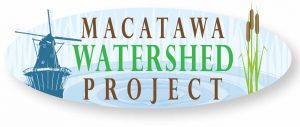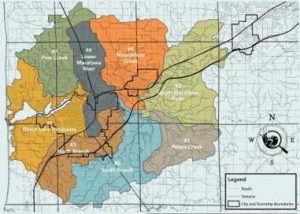Hope College Student Research Presentations
Holland Sentinel “Living Sustainably Column” Article.
“Four groups of Hope College Advanced Environmental Seminar students presented the results of their semester long research projects on December 6 at the Macatawa Watershed Annual Meeting. All student groups focused on some aspect of heavy metals. Copies of their presentations are available here.

The team of Andrew Klein, Analise Sala and Cleveland Tarp looked at heavy metals concentrations in catfish and perch in Lake Macatawa and the Macatawa River. They caught fish from five locations in Lake Macatawa and one location in the Macatawa River. They measured concentrations of copper, lead, cadmium, and iron in each fish. They compared their results to recommended exposure levels and looked for relationships between concentrations and species, and concentrations and location. For all metals except iron, they did find elevated levels in fish tissue. No correlations were found between concentration and species or location. The MACC will continue to work with local partners to determine if further study of this issue and subsequent action is necessary.
The team of Sandra Brookhouse, Kaitlyn Caltrider and Samuel Click evaluated the effectiveness of different materials at removing heavy metals from stormwater runoff. In a laboratory setting, they poured different known concentrations of heavy metals through tubes filled with soil and other materials, specifically vermiculite and hugelkultur, and measured the concentrations of heavy metals in the liquid after it filtered through the tubes. They found that both vermiculite and hugelkultur removed heavy metals from the solution to levels well below recommended drinking water exposure. They are optimistic that these materials could be used to help remediate heavy metals in stormwater runoff.
The team of Alex Donaldson, Ian Gorgenson and Jared Jaent looked at concentrations of heavy metals in drinking water and the soil around Hope College’s Campus. The first part of their project involved testing drinking water from 10 locations for the presence of lead and copper. When they did not find any heavy metals present in any of their samples, they turned their focus to heavy metals in soils. Pipe corrosion had been an issue at the Western Theological seminar and they were curious how this may have an impact on the surrounding soils and potentially groundwater. They focused on copper lead and iron and did not find any concentrations in the soil above the recommended limit for exposure.
The team of Liam Kleinheksel, Elizabeth Morehead and Jacob Stid investigated the uptake of heavy metals by a few common garden vegetables. This could be a concern in urban areas contaminated with heavy metals where urban farming is becoming more popular. The looked at uptake of copper, lead and cadmium by radishes, spinach and arugula. In a laboratory setting, they simulated rainfall events with water that contained various concentrations of the 3 metals. At high concentrations of cadmium and copper, they did see uptake of heavy metals above the recommended exposure rate in arugula and radish (copper only). Their study also seemed to indicate that vegetables do not grow as vigorously when subject to high levels of heavy metals, specifically copper.”


